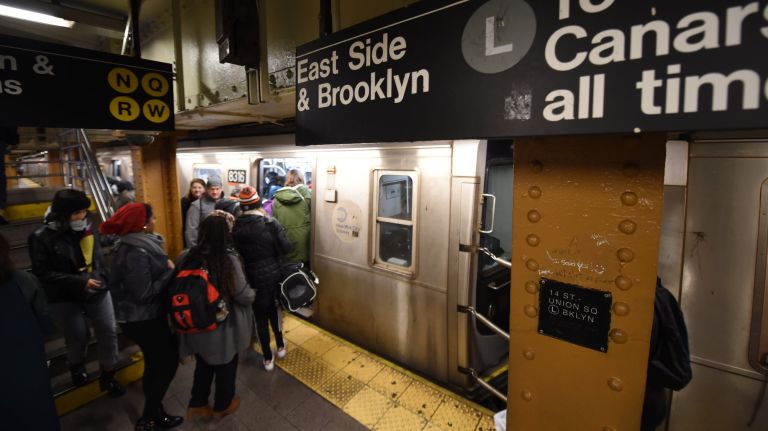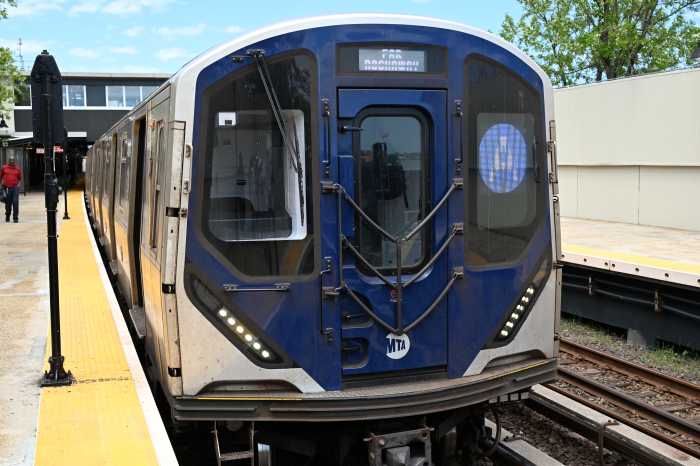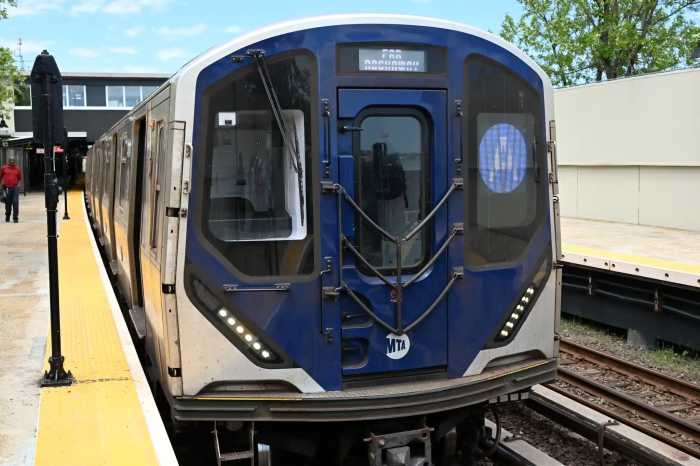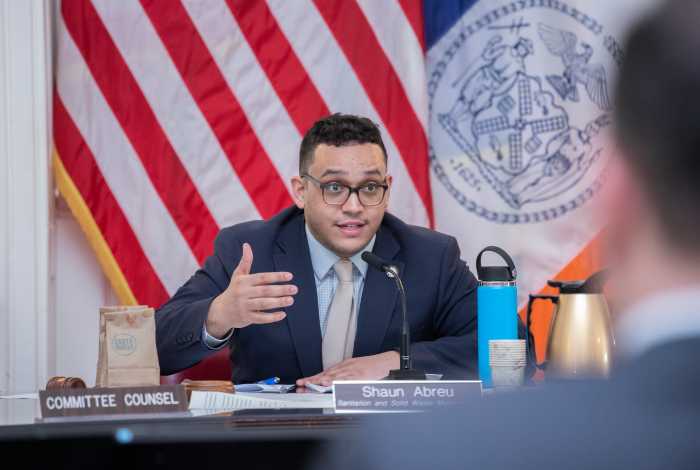
As construction ramps up, so is the anxiety surrounding the MTA’s partial L train shutdown.
With work officially beginning next weekend to repair the L line’s Sandy-damaged Canarsie Tunnel, riders, advocates and workers are bracing for a bumpy ride as the MTA hastily hammers out details around the new rehabilitation plan Gov. Cuomo unveiled by surprise in January.
“I’m giving up on the L train and driving more now,” said Nadia Dell, 55, of Williamsburg, who restores antique furniture. “It takes about three trains before you actually get to get on because it’s so crowded. It’s going to be unbearable. It’s going to be horrendous.”
While the MTA has implemented a series of service outages on the line to prepare for the partial closure, the rehabilitation starts in earnest April 26. The MTA will reduce L service to one tunnel track at a time, handling three trains an hour in each direction. That means 20-minute waits on all weekends and all nights, with service reductions beginning at 8 p.m. during the week. That likely will translate to serious service reductions for 400,000 daily L riders at certain hours.
On a regular Sunday, for example, the MTA schedules a Brooklyn-bound L train to pass through Union Square every four to six minutes during most of the day and at night.
L train riders like Natalya Hutson, of East New York, are begrudgingly planning to sacrifice more of their time to get around. Hutson, 20, regularly works weekends at a supermarket in Williamsburg.
“The first month it’s going to be hectic, but after people are going to get used to it,” she predicted.
The MTA plans to add trains on nearby G, M and 7 subway lines and increase M14A service in Manhattan. The authority will also launch two shuttle routes to move riders between L stations and the nearby J, M and G lines in north Brooklyn. Advocates, however, remain concerned by the unfinished details and feel the city and MTA have executed the bare minimum in attempts to avoid dangerous overcrowding at subway stations.
There still is not an official timeline for the new project. The MTA continues to hammer out the new contract with the companies doing the work: Judlau and TC Electric. Janno Lieber, the MTA’s construction chief, said the new project will take between 15 and 18 months, and she expects it to be less expensive than the $477 million contract for the original, full 15-month closure.
“I’m confident that we’re going to be able to knock it out on schedule and in budget,” Lieber assured during a board meeting Monday.
The original contract included substantial fines for each day the project was late, as well as money banked to incentivize an early completion. MTA spokesman Maxwell Young said the new contract would also include incentives and penalties, but didn’t elaborate as to whether they’d reach the same levels as the initial contract.
Preliminary ideas for a 14th Street bus-only corridor, along with a new Select Bus Service for the M14, appear to have been mothballed by a seemingly ambivalent de Blasio administration, after MTA executives signaled that the busway would likely not be necessary. SBS service is now expected to come by June, though the MTA is still debating proposed service changes with local residents.
“It doesn’t look like they’re ready to handle the potential catastrophe that is going to come with so many L train riders’ commutes being disrupted,” said Joe Cutrufo, a spokesman for the nonprofit Transportation Alternatives, which aggressively advocated for a 14th Street busway. “Twenty-minute headways during nights and weekends is going to have a bigger impact than I think they’re planning for.”
Lisa Daglian, the executive director of the Permanent Citizens Advisory Committee to the MTA, is also concerned about potential overcrowding and she worried whether the MTA will be able to move its work trains out of the way to avoid delays in service — especially when construction has to wrap on Monday mornings.
“People should take practice runs on the other lines … to figure out how they’re going to make that commute on Monday morning because it’s going to be a different day,” Daglian said. “So now is a good time to try some of the alternatives in case option A is too crowded.”
The surprise announcement from Cuomo, who effectively controls the MTA, upended years of planning for the tunnel’s rehabilitation. But officials at the authority have stressed they’re ready, and have downplayed the potential disruption of the new rehabilitation strategy.
“We’ve got to keep people moving along that corridor,” said NYC Transit President Andy Byford on Monday. “The good news being, of course, … that for 90 percent of the riders there is no change because the line remains open; it’s nights and weekends when we have to provide an alternative service plan.”
Activists within the MTA’s own workforce have begun organizing to warn of safety issues the new plan could pose to riders and workers through improper dust mitigation. Riders and workers have already complained of uncomfortable dust levels at the L’s Bedford Avenue station.
The group Transit Workers for Social Justice joined others in criticizing the authority for failing to abide by the MTA board’s request for an independent assessment of the feasibility and safety of the new construction plan.
Ronnie Hakim, the MTA’s managing director, has dismissed those workers as a “fringe” group that is involved in “dangerous pandering” with the project. The workers argue that the MTA and their union are trying in earnest to follow the marching orders of the governor, who is close with the transit union, Transportation Workers Union Local 100.
Workers were rankled when MTA issued a bulletin, dated last Friday, advising employees that in the rare emergency requiring passenger evacuation from the Canarsie Tunnel riders must not be led onto the tunnel’s bench wall. There will be “no clear passage” during the repairs and crews must instead lead passengers onto the track bed or into a rescue train.
The bench wall, which has been damaged and will be encased in a fiber-reinforced polymer, is typically the safest area to lead passengers evacuated in a train tunnel, because it avoids tripping hazards and other dangers on the tracks, according to John Ferretti, a subway train conductor.
“The governor has come in, runs everybody over and does whatever the real estate interests in Williamsburg think is going to safeguard their profits. And to safeguard their profits, they’re going to risk our lives,” Ferretti said.
“[Evacuations] are the last thing they thought about,” Ferretti said, on the timing of the bulletin. “And they’re trying to cover themselves.”
Young, the MTA spokesman, said in a statement that the procedure outlined in the bulletin is safe and typical in other systems with narrower train tunnels.
"Evacuating a car to anything other than a separate train or a station platform is an extraordinarily rare occurrence, is absolutely safe, and is standard procedure in major transit systems like the London Underground, and in our system on elevated tracks where evacuation to the roadbed is required in order to reach the walkway," Young said. "These sorts of evacuations are something our entire staff is already trained for, and would be accompanied by FDNY and NYPD."
With Alison Fox








































